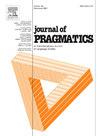它的突出是她的突出:论命题与个体回指指称的关系
IF 1.7
1区 文学
0 LANGUAGE & LINGUISTICS
引用次数: 0
摘要
同一个命题可以被编码,例如,在复合句中作为主句或从句。这样的结构结构影响一个命题是否以及如何在随后的话语中建立起来,例如通过回指引用。这是一个开放性的问题对个体和命题的回指在多大程度上以同样的方式起作用命题是否可以被提及的机制和个体指称物是否可以被提及的机制是否相同?它们对两者的影响相似吗?我们提出了三组成对的德语照应解决实验,操纵两个竞争实体之间的突出关系:在每对实验中,我们测试了两个子句如何在结构上整合,在一个实验中对个人参照的影响,在另一个实验中对命题参照的影响。每对实验的操作(句法结构和排版)是相同的,但在实验对之间,我们改变了两个子句之间的话语关系类型(向后因果关系,向前因果关系,违反期望)。我们发现命题的突出程度和个别指称物之间的基本对应模式,独立于两个子句之间的修辞关系类型。我们认为这是由于我们称之为“突出继承”的过程:单个指针“继承”了它们所属的较大单位的相对突出。本研究首次将个体显著性和命题显著性并行研究,为二者之间的异同以及结构和语用因素如何影响可及性和指代消解提供了新的见解。本文章由计算机程序翻译,如有差异,请以英文原文为准。
Its prominence is her prominence: On the relationship between propositional and individual anaphoric reference
The same proposition can be encoded e.g. as a main clause or as a subordinate clause in a complex sentence. Such structural configurations influence whether and how a proposition is subsequently built upon in the discourse, e.g. by anaphoric referral. It is an open question to what extent anaphoric reference to individuals and propositions works in the same way: are the same mechanisms responsible for whether a proposition can be referred to as for whether an individual referent can be referred to? Do they affect both similarly?
We present three sets of paired anaphor resolution experiments in German manipulating the prominence relation between two competing entities: in each pair we tested the influence of how two clauses are structurally integrated on individual reference in one experiment, and on propositional reference in the other. The manipulations (syntactic configuration and typography) were the same in each pair, but between experiment pairs, we varied the type of discourse relation between the two clauses (backward causality, forward causality, violation of expectation). We find a basic pattern of correspondence between the prominence level of the proposition and of the individual referents, independent of the type of rhetorical relation between the two clauses. We propose that this is due to a process we dub Prominence Inheritance: individual referents “inherit” the relative prominence of the larger units they are part of. Our study investigates individual and propositional prominence in parallel for the first time, providing new insights into the differences and similarities between them, and into how structural and pragmatic factors impact accessibility and anaphor resolution.
求助全文
通过发布文献求助,成功后即可免费获取论文全文。
去求助
来源期刊

Journal of Pragmatics
Multiple-
CiteScore
3.90
自引率
18.80%
发文量
219
期刊介绍:
Since 1977, the Journal of Pragmatics has provided a forum for bringing together a wide range of research in pragmatics, including cognitive pragmatics, corpus pragmatics, experimental pragmatics, historical pragmatics, interpersonal pragmatics, multimodal pragmatics, sociopragmatics, theoretical pragmatics and related fields. Our aim is to publish innovative pragmatic scholarship from all perspectives, which contributes to theories of how speakers produce and interpret language in different contexts drawing on attested data from a wide range of languages/cultures in different parts of the world. The Journal of Pragmatics also encourages work that uses attested language data to explore the relationship between pragmatics and neighbouring research areas such as semantics, discourse analysis, conversation analysis and ethnomethodology, interactional linguistics, sociolinguistics, linguistic anthropology, media studies, psychology, sociology, and the philosophy of language. Alongside full-length articles, discussion notes and book reviews, the journal welcomes proposals for high quality special issues in all areas of pragmatics which make a significant contribution to a topical or developing area at the cutting-edge of research.
 求助内容:
求助内容: 应助结果提醒方式:
应助结果提醒方式:


